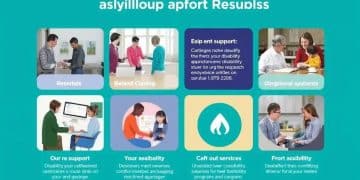Disability benefits and support services you should explore

Disability benefits and support services provide essential assistance to individuals with disabilities, including financial support, vocational rehabilitation, and access to resources that enhance quality of life and promote independence.
Disability benefits and support services play a crucial role in assisting individuals with disabilities. If you’ve ever wondered what options are out there for you, you’re not alone. Let’s dive into the various forms of support available.
Understanding disability benefits
Understanding disability benefits is essential for those who are eligible or who may need assistance due to a disability. These benefits can provide crucial support in various aspects of life, ensuring that individuals can maintain a standard of living during challenging times.
Types of Disability Benefits
There are several types of benefits available, each catering to different needs and situations. Some of the main categories include:
- Social Security Disability Insurance (SSDI)
- Supplemental Security Income (SSI)
- Veterans Affairs (VA) benefits
- State-specific programs
Each of these programs has its eligibility requirements and application processes. For instance, SSDI is designed for individuals who have worked and paid into the system, while SSI is geared more towards those with limited income and resources.
How to Apply for Benefits
The application process can sometimes be overwhelming, but understanding the steps can make it easier. Start by gathering necessary documentation such as:
- Medical records
- Work history
- Income statements
- Identification documents
Once you have your documents ready, you can apply online or through your local Social Security office. It’s essential to provide accurate information to avoid delays.
Applying for disability benefits may take time, and many applications are denied initially. If this happens, do not get discouraged. You can request a reconsideration or appeal the decision, and having a qualified advocate can significantly improve your chance of success.
Knowing your rights and understanding the benefits available to you can empower you in this journey. Many communities also offer resources, support groups, and assistance in navigating the system.
Types of support services available
When looking at support services for individuals with disabilities, it’s important to recognize the various types available. These services can significantly enhance the quality of life and provide essential assistance.
Categories of Support Services
Support services can be grouped into several categories that cater to different needs. These include:
- Vocational rehabilitation services
- Personal care attendants
- Counseling and mental health services
- Transportation services
Each of these services plays a vital role in helping individuals manage day-to-day challenges while promoting independence.
Vocational Rehabilitation Services
Vocational rehabilitation services help individuals with disabilities prepare for, find, and maintain employment. These programs often include job training, resume writing assistance, and interview preparation. They focus on building skills that allow individuals to succeed in the workforce.
By offering these specialized supports, the aim is to create a smoother transition into the workplace for people with disabilities and enhance their overall economic stability.
Personal Care Attendants
Personal care attendants provide necessary support with daily activities, such as bathing, dressing, and meal preparation. This type of support is crucial for individuals who may require help due to mobility issues or other disabilities. By having a dedicated caregiver, individuals can maintain their dignity and independence while ensuring their basic needs are met.
Additionally, this service can help improve mental well-being by offering companionship and social interaction, reducing feelings of loneliness.
Transportation Services
Access to reliable transportation is another critical support service. Many individuals with disabilities may struggle with mobility or may not be able to drive. Transportation services can help them access essential locations such as healthcare facilities, job interviews, and recreational activities. These services can greatly enhance mobility and allow for greater participation in the community.
Through understanding and utilizing these various types of support services, individuals with disabilities can navigate their challenges more effectively and enjoy a higher quality of life.
How to apply for disability benefits

Applying for disability benefits can feel overwhelming, but understanding the steps involved can simplify the process. Knowing what to expect can help individuals better prepare their applications.
Gather Necessary Documentation
The first step in applying for benefits involves collecting important documents. These may include:
- Your Social Security number
- Medical records detailing your disability
- Work history, including jobs held and your earnings
- Identification documents such as a driver’s license or state ID
Having these documents organized and ready can make the application process smoother.
Ways to Submit Your Application
There are multiple ways to apply for disability benefits. You can choose the method that is most convenient for you:
- Online: The Social Security Administration has a user-friendly online application that you can complete at your own pace.
- By phone: You can call the Social Security Administration and apply over the phone if you prefer speaking with someone directly.
- In person: Visiting your local Social Security office is another option. Be sure to set an appointment to avoid long wait times.
Regardless of the method, be prepared to answer questions about your medical condition and its impact on your daily life.
Understanding the Review Process
After submitting your application, it will be reviewed by the Social Security Administration. This process can take several months. During this time, they may request additional information or medical records.
If your application is denied, don’t get discouraged. You have the right to appeal the decision. Many initial applications are denied, so it’s essential to know that this is not the end of the road. Seeking assistance from an advocate or attorney can improve your chances of success during the appeal process.
Applying for disability benefits may seem daunting, but knowing the steps and being prepared can make a significant difference.
Common misconceptions about support services
Understanding the truth about support services is vital for individuals with disabilities. Many people have misconceptions that can create barriers to accessing these essential resources. Let’s clear up some of these common misunderstandings.
Misconception 1: Support Services Are Only for Severe Disabilities
One prevalent myth is that only those with severe disabilities qualify for support services. In reality, there are various types of services available to assist individuals with a wide range of disabilities. Whether a person has a physical or mental impairment, there are programs designed to help.
Misconception 2: You Have to Be Unemployed to Receive Support
Another common belief is that assistance is only available to those who do not work. Many support services are designed to promote independence and help individuals maintain employment. Resources like vocational rehabilitation can help people with disabilities stay in the workforce and thrive in their jobs.
Misconception 3: Applying for Support Services Is a Quick Process
Some individuals think that applying for disability support services is a straightforward and quick process. However, navigating the system can often be complex and time-consuming. It may take weeks or even months for applications to be processed. Understanding this can help applicants be more prepared for the wait.
Misconception 4: Support Services Cost Money
Many people assume that accessing support services requires a hefty fee. However, most government-funded services are provided at little to no cost to individuals who qualify. This financial support aims to ensure that everyone can access the help they need without the burden of added costs.
Becoming aware of these myths is the first step towards making better-informed decisions about accessing support services. Dispellng these misconceptions empowers individuals to seek the assistance they deserve and enhances their quality of life.
Resources for navigating the system
Navigating the system for disability benefits can be a complex task. However, many resources are available to help individuals understand their options and find the assistance they need. Utilizing these resources can make the process smoother and less overwhelming.
Online Resources
The internet is a treasure trove of information. Various websites provide detailed guidance on applying for benefits. Some valuable online resources include:
- The Social Security Administration (SSA) website
- National Disability Rights Network (NDRN)
- Disability.gov
- Local government websites
These sites offer comprehensive information, FAQs, and tutorials on how to apply for benefits, ensuring you have the necessary resources at your fingertips.
Local Community Organizations
Many communities have local organizations dedicated to assisting individuals with disabilities. These organizations often provide free services, such as:
- Workshops on how to apply for benefits
- One-on-one consultations
- Support groups for sharing experiences
- Information on available local resources
Connecting with a local organization can provide personalized support and help you feel more confident in navigating your options.
Advocacy Groups
Advocacy groups play a crucial role in helping individuals with disabilities understand their rights. They can guide you through the application process and help you appeal if your application is denied. These groups often have legal experts who can provide advice if disputes arise.
Utilizing these resources effectively can empower individuals with disabilities, making the path to receiving support services less daunting. Whether through online tools or local organizations, understanding the available resources is essential for successfully navigating the system.
In summary, accessing disability benefits and support services can greatly improve the quality of life for individuals with disabilities. Understanding the various types of benefits, the application process, and the resources available can empower individuals to navigate the system confidently. By clearing up misconceptions and utilizing available resources, individuals can find the support they need. Remember, you are not alone; many organizations and communities are ready to help you on your journey.
FAQ – Frequently Asked Questions About Disability Benefits and Support Services
What types of disability benefits are available?
There are various types such as Social Security Disability Insurance (SSDI) and Supplemental Security Income (SSI), among others.
How can I apply for disability benefits?
You can apply online, by phone, or in person at your local Social Security office.
What common misconceptions exist about support services?
Many believe that support services are only for severe disabilities or that they have to be unemployed to receive assistance.
Where can I find resources to help navigate the system?
Resources include online sites, local organizations, and advocacy groups that offer assistance and guidance for applicants.





